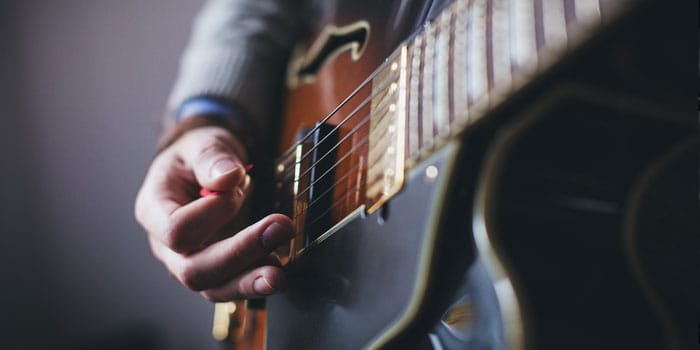HOW TO TRACK YOUR PROGRESS
WITH A METRONOME

The metronome is a good tool, to keep track of your musical progress over time. But keep in mind, that if you want to play anything to a metronome, you always should be able at first, to play the excerpt fluently. You can than use the metronome to check up, at which speed you begin to find flaws in your playing.
For example, you can use the metronome to find out how fast you can change between chords. You can do this by strumming a chord when the first klick occurs and than changing to the next chord as soon as the next klick occurs. You than simply write out the fastest tempo, in which you where able to play the chords cleanly, which you are practicing with.
Another thing where you can track your progress are riffs and solos on whom you work. You simply use the metronome as your basic beat (for the quarter notes) and write down the fastest speed, at which you where able to play them cleanly.
The disadvantage of doing this is, that you won't be working on the same solos or riffs for months or years, so you won't have a constant track record over a long period of time, of how much you improved in certain areas. I would recommend instead something different, to have a good comparison of a before and after of your playing over a longer period of time.
Instead of riffs and solos you should use exercises, which take specific techniques into consideration, which enables you to have a comparison of every single technique over a longer period of time.
You could come up with specific rhythm exercises, which are focused on different aspects, such as downstrokes only, alternating between upstrokes and downstrokes, playing with palm muting and alternating between palm muting and open playing. You can track for each one of them the fastest tempo once in a while, on which you where able to play them cleanly.
You can do the same with lead guitar and consider different techniques in isolation:
1. Scales
Come up with simple (or complicated) scale patterns which can be applied all around the guitar neck and can be used in your everyday guitar playing.
2. Arpeggios
To track your progress by Sweep Picking, you can come up with different Arpeggio shapes which you can apply into your guitar playing, consisting of major, minor, seventh chords etc. and are played on different amounts of strings (e.g.: 3 string Arpeggios and 5 string Arpeggios).
3. Legato
Create exercises which are made up by legato techniques (hammer ons and tapping), which could be used and adapted in your guitar playing.
I've emphasized on purpose that you should use exercises, which you can integrate into your guitar playing. This is important, because if you use patterns which you can't apply in your playing - like chromatic scales for example - this exercises will have less value for your musical progress.
To track your progress, you may use your metronome as the basic beat for quarter notes, to determine up to which speed you can play these exercises cleanly.
You can note down your top speed in the following way: You multiply the speed of the basic beat with the amount of notes you hit per beat (per quarter note).
Let me give you an example to clarify this: If you play sixteenth notes and your basic beat is at 100 bpm (beats per minute), you are playing 400 notes per minute, because you are hitting 4 sixteenth notes per beat (100 x 4 = 400).
Another example: If you play eighth notes triplets and your basic beat is at 100 bpm (beats per minute), you are playing 300 notes per minute, because you are hitting 3 eighth notes triplets per beat (100 x 3 = 300).
I hope you are able to see now, how you can progress your technical abilities over a long period of time. Keep on progressing!
This article was written by Marco von Baumbach, guitar teacher in Wuppertal, Germany.If you are interested in the author, check out his website about Gitarrenunterricht in Wuppertal


Dylan is an incredible teacher and a reliable instructor. I've been taking lessons with Dylan for over 6 years and he has helped me improve so much over that time. He has helped me with song writing, guitar techniques, and music theory over the course of our many lessons. I highly recommend Dylan as a teacher!
"Dylan is a fantastic teacher. I've been playing on and off for 10 years and could never figure out how to solo. After only 3 months of lessons, I am soloing up and down the entire neck (and it actually sounds good!). I would highly recommend lessons with Dylan."
"I've been taking lessons from Dylan for about eight or so months now. And without a doubt, they have been an awesome eight months. its structured, but doesn't feel like a normal classroom setting where you sit and listen. He walks you through everything, and makes sure not to overwhelm you. I've learned a lot and have also started to learn bass from him, which after only two weeks is proving to be just an enjoyable. Definitely check him out if you're ever interested Iearning how to play the guitar!"
"My son took lessons from Dylan and learned a tremendous lot! His lessons are challenging but fun! Very highly recommended."
"Dylan is an excellent teacher. He has customized each lesson to suit my level. This is my first time taking lessons and he has been very patient. I have progressed very quickly and had a lot of fun with Dylan. He has a great personality for teaching and is very skilled."
Home | Who’s The Fastest Guitar Player In The World (And Why You Shouldn't Care) | Improving The Sound Of Your Strum So That You Can Sound More Professional | 3 Easy Ways To Make Practice Fun Every Time You Pick Up Your Guitar | How To Encourage Your Child To Practice Their Guitar| 5 Ways To Get More From Your Guitar Lessons | Battling Discouragement As You're Learning To Play The Guitar| Fun Way To Build Picking Hand Independence for Beginner Guitarists | Becoming A Self-Effulgent Musicians | 9 iPad Apps That Will Greatly Enhance Your Playing | Learn To Master Scales | Choosing The Best Guitar Pick | How To Practice Bend Intonation | About | Guitar Lessons For Kids | How To Track Your Progress With A Metronome | How To Buy Your Kids First Guitar | What To Expect On Your Guitar Journey | 5 Things You Can Do To Make Your Guitar Practicing More Effective And Reach Your Goals Sooner | How Bruce Lee Will Make You A Better Guitar Player | What To Expect On Your Guitar Journey | Contact



